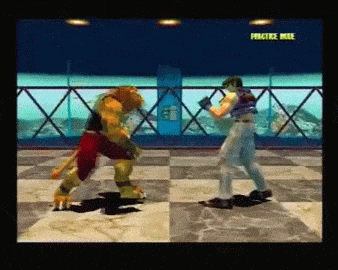Truly Unique Fighting Games
The fighting game genre is renowned for its intense, fast-paced combat and technical depth, but some games push the boundaries further by introducing unique mechanics that challenge traditional gameplay paradigms. Here's a deep dive into several games that have reshaped what we expect from combat in video games, offering fresh, innovative systems that stand out in the genre.
Virtual On
Virtual On utilizes a distinctive control system with twin sticks that manage both movement and combat, setting it apart from traditional fighting games. This setup allows players to engage in battles using giant robots in spacious 3D arenas, where strategic positioning and precision attacks are key. The twin-stick controls enable rapid changes in both positioning and targeting, demanding high coordination and situational awareness from players, creating a gameplay experience that is as tactical as it is thrilling.
Bloody Roar
Bloody Roar offers a dynamic twist to the fighting game formula by allowing characters to transform into powerful beasts, changing their moveset and abilities mid-fight. This mechanic introduces a strategic layer where the timing of transformations can significantly affect the battle's outcome. Managing the transformation meter becomes crucial, as players must decide the best moments to unleash their alter ego, balancing between offensive onslaughts and defensive retreats, adding a unique rhythmic flow to each match.
Bushido Blade
Bushido Blade breaks from traditional fighting games by eliminating health bars and instead focuses on a realistic damage model where one well-placed strike can be fatal. This system emphasizes precision, timing, and a deep understanding of weapon range and movement. The gameplay promotes a cautious and methodical approach, encouraging players to think critically about every swing and parry. This creates intensely suspenseful duels that are as much about psychological warfare as they are about physical combat.
Psychic Force
Set in a cubic, zero-gravity arena, Psychic Force is a game where characters use psychic abilities to battle in mid-air, pushing the boundaries of traditional 2D or 3D fighting planes. This unique environment allows for full-range movement and attacks from any direction, complicating the standard fighting game strategies and demanding players adapt to a truly three-dimensional combat space. The gameplay is centered around mastering these abilities and using the arena's spatial dynamics to outmaneuver opponents.
ARMS
ARMS brings a fresh perspective to fighting games with its extendable arms mechanic and customizable arm types that affect combat strategy. The game emphasizes spatial awareness and timing, as players must gauge their punches and dodge incoming attacks using the 3D space effectively. This system, combined with a colorful and distinctive art style, offers a playful yet deep tactical gameplay experience where choosing the right combination of arms and mastering their specific traits can lead to victory.
Tobal No. 1
Tobal No. 1 features an innovative grappling system that integrates seamlessly with its striking mechanics, offering a level of depth in close-quarters combat rarely seen in other fighters. The freedom of movement in a fully 3D arena, combined with a diverse roster of characters and their unique fighting styles, makes it a game where mastering the nuances of both grappling and striking is essential. Additionally, its Quest mode introduces an RPG-like exploration element, expanding the traditional fighting game experience.
Rumble
Rumble reimagines the fighting game landscape by incorporating full environmental interaction within its combat system. Players must use the dynamic arenas to their advantage, manipulating elements within the environment to create hazards for opponents. The focus shifts slightly from direct combat to strategic environmental awareness, where controlling space and using the surroundings effectively becomes as important as landing punches.
Gang Beasts
Gang Beasts offers comically chaotic combat with its gelatinous characters and physics-based mechanics. The unpredictable and often hilarious outcomes of fights are driven by the game's emphasis on environmental hazards and the awkward, yet strategic control of the characters. Players must navigate both the intentional clumsiness of their characters and the dangerous settings, making for a riotous and engaging party game experience.
Smash Brothers
Super Smash Brothers redefines the platform fighter genre by combining elements of traditional fighting games with platforming. Characters battle to knock each other off stages rather than depleting life bars. Each character's unique abilities and the importance of stage control add layers of depth and strategy. The game’s emphasis on adaptability, with constantly changing arenas and the inclusion of various items, creates a dynamic combat experience that is both accessible and deep.
Hellish Court
Hellish Court uses physics-based mechanics to simulate realistic swordplay that relies on actual historical European martial arts. Each duel is about skillful manipulation of the blade, with a focus on stances, parries, and the precise impact of each strike. The game offers a combat experience that is meticulously detailed, requiring players to pay close attention to their movements and their opponent’s intentions, making every encounter a deadly dance that could end with a single, well-placed blow.
These games each challenge traditional fighting mechanics, offering players unique experiences that are as diverse in gameplay as they are in their creative ambitions. Whether through the manipulation of physical laws, the reimagining of combat spaces, or the integration of life-like fighting techniques, these titles expand the horizons of what fighting games can offer.







